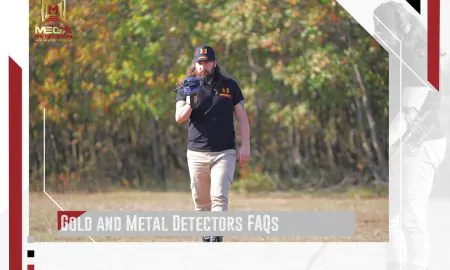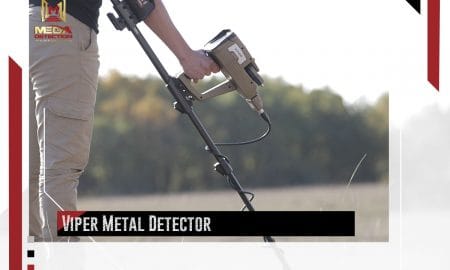Frequently Asked Questions About Gold and Metal Detectors
How Does a Metal Detector Work?
A metal detector is a professional device that consists of a carrying handle (usually with a support device for your forearm), a control box at the top, an extendable shaft, and a search coil. So, how do metal detectors work (simple explanation)?
A metal detector works by transmitting a signal into the ground. When the detector coil passes over a metallic target, it receives a return signal that the detector’s electronics can interpret as a target. This interpreted signal is presented to the user via the control box as a visual display, an audible tone, or both. The coil is responsible for the detection of metal, the control box contains the interpretive circuitry and headphone jack, and the shaft adjusts for proper distance between the operator and the ground.
What is Metal Detector Coil?
Metal Detector Coil operate by sending an electrical current through a coiled copper wire to generate a magnetic field (this coil is called the transmit or TX coil). When this magnetic field encounters metal it induces an equal opposing current which is sampled by the receive or RX coil.
At a basic level every commercially sold metal detector either works through pulse induction or very low frequency technology.
How to Increase the Depth of a Metal Detector?
How deep do metal detectors detect is a question that can be difficult to answer. The reason is that each device has a different level of depth. But one thing applicable for all metal detectors is increasing their detection depth.
To increase the depth of a metal detector, you can: sweep the coil close to the ground – increase the – sensitivity setting – reduce the discrimination setting – install fresh batteries – upgrade to larger coil.
How deep do metal detectors detect? The truth is that there is no exact number that can answer this question since these devices are so diverse and exist with many capabilities. So, there are no actual numbers that tell the depth level that a metal detector can reach.
Additionally, the size of the object to be found affects how deep metal detectors can detect. However, you can always increase the depth level of a metal detector.
Increasing the depth of your device will allow you to find old relics and objects that detectors are not too sensitive and often miss.
What are Hot Rocks In Metal Detecting?
Hot Rocks (sometimes known as “Cold Rocks”) are rocks, pebbles, or sediment, which contain higher or lower amounts of conductive or non-conductive minerals relative to the ground around them. Specifically, related to what your metal detector is manually or automatically ground balanced.
There are two main forms which Hot Rocks In Metal Detecting can be classified into. Firstly, Positive Hot Rocks, which contain higher amounts of conductive material. Secondly, Negative Hot Rocks, also known as “Cold Rocks” which contain higher amounts of non-conductive material.
Negative Hot Rocks In Metal Detecting are very non-conductive as they contain (usually) high concentrations of Magnetite. Magnetite is an Iron Oxide and will often cause the rock or sediment which it is in to become dark black in color. Additionally, it will cause the rock or sediment to become heavy due to the high atomic weigh of the Iron Oxide Molecule. One of the most common ways to encounter this type of Hot Rock is “Black Sand”. This is just as it sounds, sand which is dark, or black, in color, and abundant in Magnetite.
What does Metal Detector Discrimination Mean?
Metal detector discrimination or DISC is a feature, commonplace among relatively newer metal detectors, by which certain metals can be ignored as to avoid common but low value objects. Modern DISC will often start with leaving out any signals received from iron metal, moving on to tin foil, then steel bottle caps, finally moving into some variation of specifically detecting various coins, gold rings, and possibly other precious metals.
However, a great deal of older detectors will simply include a dial which, while still signaling for the metals, will show the user what metal a target may be. Moreover, even older metal detectors might simply come with a dial which is associated with numbers that signify the strength of the signal detected. This number can then be associated with general signal strengths of various objects and types of metal.
What is Pulse Induction (PI) in Metal Detecting ?
Pulse Induction (PI) a metal detector coil technology (the other is Very Low Frequency) which creates an electromagnetic field and then allows it to collapse (this is the pulse). Pulse Induction metal detectors offer no discrimination features, however are often used because they are not affected by mineralized ground.
What Metals Cannot Be Detected by a Metal Detectors?
A metal detector cannot find metals with low electrical conductivity. The device works by transmitting and receiving electromagnetic fields. Hence, metals need to be good conductors for it to detect them. The most challenging metal for a metal detector to detect is stainless steel.
Metal detectors work excellently for finding valuable objects like coins and jewelry. Since such a device can detect ferrous and non-ferrous metals, it can be pretty easy to pinpoint where your targets are buried.
How To Eliminate Unnecessary Targets When Metal Detecting?
To eliminate unnecessary targets with a metal detector is one method to avoid catching trashy signals. It also allows your tool to focus on detecting valuable objects like coins. But how does a metal detector eliminate ?
Metal detectors can eliminate unnecessary targets detection through discrimination. These tools can discriminate between ferrous and non-ferrous metals. for example Aluminum is non-ferrous, so the inductance of the detector’s search coil will reduce.
It is essential to understand how discrimination works and how it eliminates unnecessary targets. But another critical factor is to learn some tips on finding valuable objects in places with too much garbage.
Related Articles
- Gold Detectors 2022
- VLF Metal Detector
- 3D Metal Detectors || All You Need To Know
- Pulse Induction Metal Detector
- Metal Detector Prices , How Much Does a Metal Detector Cost?
- How to Choose the Best Gold Detectors 2022
- How Does a Metal Detector Work?
- 3D Gold Detector












Leave a Reply